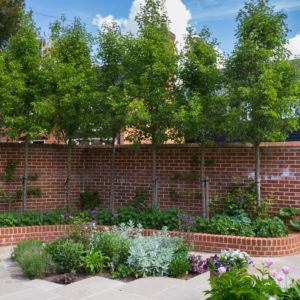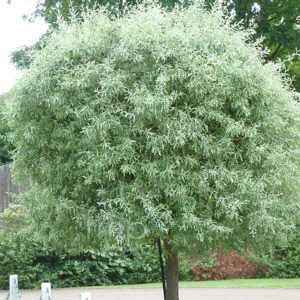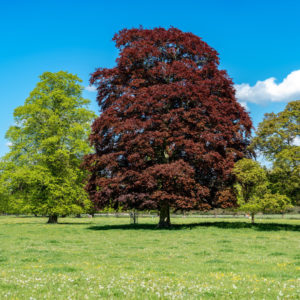Quercus rubra / Red Oak
Price range: €225.00 through €650.00
Frequently Bought Together



Description
Quick Facts
- Common Name: Red Oak, Northern Red Oak, Champion Oak
- Botanical Name: Quercus rubra
- Plant Type: Deciduous broadleaf tree
- Mature Height: 20-25m (can reach 30m in ideal conditions)
- Mature Spread: 15-20m
- Flowering Period: April to May (insignificant flowers)
- Flower Colour: N/A (grown for foliage and form)
- Foliage: Large lobed leaves, rich green turning spectacular red, orange, and russet in autumn
- Hardiness: RHS H7 (fully hardy throughout UK and Ireland)
- Soil Requirements: Moist, well-drained, acidic to neutral soil
- Aspect: Full sun to partial shade
- Maintenance: Low
Description
Experience the breathtaking beauty of Quercus rubra, one of the most magnificent and fast-growing oak trees for gardens and landscapes, where impressive stature, bold architectural foliage, and spectacular autumn colour combine to create living landmarks of extraordinary presence that transform spaces with year-round structure and bring unforgettable seasonal displays of fiery reds and russets rivalling the finest New England Autumn foliage. This exceptional tree offers remarkable qualities—spectacular autumn colour transformation when large lobed leaves turn brilliant shades of rich red, russet-red, orange-red, and burgundy creating breathtaking displays that rival any ornamental tree and bring North American fall beauty to temperate gardens, impressive bold foliage with large deeply lobed leaves measuring 12-22cm long creating substantial presence and architectural character throughout summer, fast vigorous growth for an oak adding 40-60cm annually once established making it one of the fastest-growing oak species and perfect for creating impact within reasonable timeframe, majestic pyramidal to rounded form developing broad spreading crown with age creating substantial presence and classic oak silhouette, and exceptional hardiness and adaptability thriving in wide range of conditions including urban environments, exposed positions, and challenging sites, making this one of the most rewarding and impressive choices for adding substantial presence, spectacular autumn colour, and long-lived permanence to estates, parks, avenues, and anywhere a magnificent statement tree with seasonal drama is desired.
Throughout the seasons, this captivating tree displays its characteristic bold foliage—the leaves are large and deeply lobed, measuring 12-22cm long and 10-15cm wide, with 7-11 pointed lobes separated by deep sinuses creating dramatic architectural form. Each lobe ends in a bristle-tipped point (characteristic of red oak group), giving the leaves distinctive spiky appearance. The leaves emerge in spring as bronze-red to pinkish-red creating beautiful spring colour, then mature to rich matt green throughout summer providing substantial canopy and bold texture. The leaf surface is smooth and matt (not glossy), creating soft appearance. In autumn (October-November), the foliage undergoes spectacular transformation—leaves turn brilliant shades of rich red, russet-red, orange-red, burgundy, and brown-red creating breathtaking displays that are among the finest autumn colour of any hardy tree. The autumn colour is most intense in full sun and acidic soil, with trees in these conditions developing the most brilliant reds. The display typically lasts 2-4 weeks depending on weather, with the tree becoming a beacon of colour in the autumn landscape. Following leaf fall, the impressive branch structure is revealed—young trees develop pyramidal to oval form with strong central leader and regular branching, while mature trees develop broad rounded crown with massive spreading branches creating classic oak presence and substantial canopy. The bark on young trees is smooth grey-brown, becoming deeply furrowed and ridged with age developing dark grey-brown to almost black colour creating rugged character. In spring (April-May), inconspicuous yellowish-green catkins appear—male flowers hang in clusters while female flowers are tiny and easily overlooked. Following pollination, acorns develop measuring 2-3cm long, round with shallow cup covering only the base—acorns mature in second year (biennial fruiting) turning brown in autumn and providing food for wildlife. The overall effect is majestic, substantial, and seasonally spectacular—like having a piece of North American forest thriving in your garden with autumn colour rivalling the finest fall foliage displays.
Native to eastern North America from Nova Scotia to Georgia and west to Minnesota and Oklahoma, Quercus rubra is one of the most important and widespread oak species in its native range, forming extensive forests and valued for timber, wildlife habitat, and ornamental use. The species name ‘rubra’ means “red,” referring to the spectacular autumn foliage colour and the reddish tinge of spring foliage and inner bark. Introduced to Europe in the 1720s, it quickly became valued for forestry, parkland planting, and ornamental use due to its fast growth (unusual for oaks), impressive size, and spectacular autumn colour. It’s widely planted in estates, parks, and large gardens throughout UK and Ireland where it thrives and has naturalized in some areas. The common name “Red Oak” refers to both the autumn colour and the reddish inner bark visible in fissures. Hardy to RHS H7, this exceptionally robust tree thrives throughout temperate climates with complete reliability, tolerating severe cold (to -30°C or below), exposed positions, urban pollution, and challenging conditions. Fast growth rate for an oak, adding 40-60cm annually once established (much faster than native Quercus robur), reaching impressive size within 30-40 years—this is one of the fastest ways to establish substantial oak presence. Particularly valuable for spectacular autumn colour that rivals Japanese maples and other celebrated autumn trees, fast vigorous growth creating substantial presence within reasonable timeframe, impressive bold architectural foliage providing year-round structure, long-lived permanence with trees living 200-300+ years creating legacy plantings, and excellent wildlife value with acorns providing food for birds and mammals and foliage supporting numerous insects. The substantial size and spreading crown make this perfect for large-scale plantings.
Create stunning compositions by planting as magnificent specimen tree in estates, parks, and large gardens where its impressive size and spectacular autumn colour can be appreciated as focal point and seasonal highlight, using for avenue plantings where uniform trees create formal symmetry and spectacular autumn displays along driveways and approaches, or positioning in parkland and woodland gardens where the tree has room to develop full spreading crown and natural character. Exceptional in large residential gardens where substantial presence and autumn colour are desired and space allows for mature size, as boundary or screening trees where fast growth and substantial size create privacy and shelter, or in commercial landscapes, golf courses, and public spaces where impressive presence, low maintenance, and seasonal interest are valued. Works beautifully planted as single specimens where trees develop full spreading crown and create maximum impact, in groups or groves for woodland character and massed autumn colour creating spectacular displays, or combined with other autumn-colour trees (Liquidambar, Nyssa, Acer rubrum) for extended autumn displays and layered colour. Also magnificent as backdrop to borders where the substantial presence and autumn colour provide context and seasonal drama, underplanted with shade-tolerant woodland plants (bluebells, ferns, hellebores, Cyclamen) that thrive beneath the canopy, or in mixed native/ornamental plantings where the North American character complements European natives. Perfect for adding substantial presence, spectacular autumn colour, and long-lived permanence to estates, parks, avenues, and anywhere a magnificent statement tree with seasonal drama is desired. IMPORTANT: This is a large vigorous tree requiring substantial space—unsuitable for small gardens or planting near buildings.
Caragh Garden Notebook
Planting: Space trees 15-20m apart for individual specimens allowing room for mature spread and crown development, or 10-12m apart for avenue plantings where trees will form continuous canopy. Plant bare-root specimens November-March during dormancy (ideal for best establishment and value), or container-grown specimens year-round though autumn or early spring is preferred. Choose position in full sun for best growth and most spectacular autumn colour—tolerates partial shade but growth may be slower and autumn colour less intense. Requires open position with room to develop substantial spreading crown—avoid planting near buildings, overhead wires, or where mature size will cause problems. Dig very generous planting hole at least twice width of root ball and same depth. Incorporate organic matter (well-rotted compost, leaf mould) into backfill soil to improve fertility and moisture retention, particularly important on poor soils. Plant at same depth as nursery soil mark on trunk—avoid planting too deeply which can cause collar rot. Backfill carefully, firming soil gently to eliminate air pockets. Water thoroughly after planting. Apply 8-10cm mulch of organic matter around base in 1.5m diameter circle, keeping mulch clear of trunk (10cm gap) to prevent rot. Stake young trees using single stake or double stakes with crossbar—use tree ties with spacers. Stakes support tree for first 3-4 years. Water regularly during first 2-3 growing seasons to establish deep root system—oaks develop deep taproots and require thorough watering during establishment. Position where the tree has room to grow and where spectacular autumn colour can be appreciated.
Soil Preparation: Prefers moist, well-drained, acidic to neutral soil for best growth and autumn colour. Prefers pH 4.5-6.5 (acidic to slightly acidic)—CRITICAL: unlike native European oaks which tolerate alkaline soils, Quercus rubra performs poorly on chalky or very alkaline soils and may develop chlorosis (yellowing leaves) due to iron deficiency. Best growth and most spectacular autumn colour occur on acidic soils. Tolerates range of soil types including sandy, loamy, and clay soils provided drainage is adequate. Requires well-drained soil—avoid waterlogged or poorly drained soils which cause root problems. Improve heavy clay soils by incorporating organic matter and grit to improve drainage. Improve light sandy soils by adding generous amounts of compost or leaf mould to improve moisture retention and fertility. Mulch annually in spring with 8-10cm layer of organic matter (compost, leaf mould, well-rotted manure) in 1.5m diameter circle around base to conserve moisture, suppress weeds, improve soil fertility, and maintain acidic conditions. Keep mulch clear of trunk. Best growth and autumn colour occur in full sun with moist, well-drained, acidic soil—these conditions produce the most vigorous growth and most brilliant red autumn colour.
Container Growing: Not suitable for container growing due to large mature size, vigorous growth, and deep taproot—this is a substantial forest tree requiring in-ground planting. Young specimens can be grown in containers for 1-2 years before requiring permanent planting, but will quickly become pot-bound. Plan for permanent in-ground planting in suitable location with room for mature size.
Seasonal Care: Requires minimal pruning—the naturally pyramidal form when young develops into broad rounded crown without intervention. Prune only to remove dead, damaged, or crossing branches, or to maintain single central leader if competing leaders develop in young trees. Carry out any necessary pruning in late autumn to winter (November-February) during dormancy—avoid pruning in spring when sap is rising. Remove lower branches gradually over several years if desired to create clear trunk, but avoid removing too much in one year which stresses tree. Apply general-purpose balanced fertiliser or blood, fish and bone in spring around base to promote healthy growth, particularly on poor soils. Mulch annually in spring with generous layer of organic matter. Water regularly during dry spells during first 5-7 years of establishment—once established, deep roots make tree remarkably drought-tolerant. Watch for oak processionary moth caterpillars (health hazard—report to authorities and do not touch), powdery mildew on leaves in dry conditions (usually cosmetic), and oak decline (complex condition—maintain tree health with appropriate care). Generally pest and disease free with good vigor. The spectacular autumn colour is reliably breathtaking on acidic soils!
Propagation: Can be grown from acorns collected in autumn—sow fresh acorns immediately in deep pots or directly in ground, as acorns lose viability if allowed to dry. Germination occurs in spring. Seedlings grow rapidly with deep taproots. Cannot be propagated from cuttings. Home gardeners can grow from acorns, though nursery-grown specimens provide more immediate impact and guaranteed quality.
This spectacular beauty is absolutely breathtaking—one of the finest oaks for autumn colour! That spectacular autumn transformation to brilliant shades of rich red, russet-red, orange-red, and burgundy is absolutely stunning—rivalling the finest New England fall foliage! Impressive bold foliage with large deeply lobed leaves measuring 12-22cm creating substantial architectural presence. Fast vigorous growth for an oak adding 40-60cm annually—one of the fastest-growing oak species! Majestic pyramidal to rounded form developing broad spreading crown reaching 20-25m tall. Exceptional hardiness (RHS H7)—completely reliable throughout UK and Ireland! Long-lived permanence—trees live 200-300+ years creating legacy plantings. Excellent wildlife value. CRITICAL: Requires acidic to neutral soil (pH 4.5-6.5)—performs poorly on chalky or alkaline soils! Best autumn colour in full sun and acidic soil. IMPORTANT: This is a large tree requiring substantial space (15-20m spread)—unsuitable for small gardens! Perfect for estates, parks, avenues, large gardens, and anywhere you want magnificent presence with spectacular autumn colour. Pure majestic magnificence and autumn fire!






